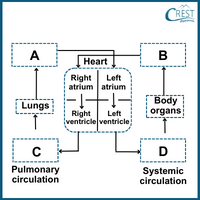1. In a study conducted on two different tree species, Species A and Species B, it was found that Species A had wider xylem vessels compared to Species B. How might this anatomical difference impact the ascent of sap in these species?
a) Species A likely has a slower ascent of sap due to wider vessels.
b) Species A likely has a faster ascent of sap due to wider vessels.
c) Species B likely has a faster ascent of sap due to narrow vessels.
d) The thickness of xylem vessels is unrelated to the ascent of sap.
Answer: b) Wider xylem vessels in a plant species, such as Species A, would typically facilitate a faster ascent of sap. This is because wider vessels offer less resistance to the flow of water. In the process of transpiration and the cohesion-tension theory, water molecules are pulled upward through the xylem vessels. Wider vessels provide a wider pathway for this water movement, allowing for a more efficient and faster transport of water and dissolved minerals from the roots to the upper parts of the plant.
2. Accurately identify the blood vessels A, B, C and D to complete the flowchart depicting double circulation in humans.

a) A: Pulmonary Vein, B: Pulmonary Artery, C: Aorta, D: Superior and Inferior Venacava
b) A: Aorta, B: Superior and Inferior Venacava, C: Pulmonary Artery, D: Pulmonary Vein
c) A: Pulmonary Vein, B: Superior and Inferior Venacava, C: Pulmonary Artery, D: Aorta
d) A: Superior and Inferior Venacava, B: Pulmonary Vein, C: Pulmonary Artery, D: Aorta
Answer: c) A (Pulmonary Vein) represents oxygenated blood returning from the lungs to the heart.
B (Superior and Inferior Venacava) represents deoxygenated blood from the body returning to the right atrium of the heart.
C (Pulmonary Artery) represents the pathway through which deoxygenated blood is pumped to the lungs for oxygenation.
D (Aorta) represents the pathway through which oxygenated blood is pumped from the heart to supply the body's tissues and organs.
3. Some desert plants, such as cacti, store water in their stems as a survival strategy. How does this water storage relate to the excretion process in these plants, and what might be the significance of water storage for their survival in arid environments?
a) Water storage inhibits excretion; it helps maintain turgidity during water scarcity.
b) Water storage inhibits excretion; it conserves water during periods of drought.
c) Water storage is unrelated to excretion; it serves as a means of defence against herbivores.
d) Water storage promotes transpiration; it enhances nutrient absorption.
Answer: b) Water storage in desert plants like cacti is a critical adaptation to their arid environments. Storing water in their stems helps these plants survive extended periods without rainfall. Water conservation is a primary goal, and this extends to minimising excretion to prevent water loss. Therefore, water storage inhibits excretion and conserves precious water resources during droughts, allowing these plants to thrive in harsh desert conditions.
4. You are a physician conducting a routine checkup on a patient. During the examination, you notice that the sphygmomanometer shows a reading of 160/90 mm Hg. What do these values represent, and should you be concerned about this reading?
a) The values represent systolic and diastolic pressures, and the patient has normal blood pressure.
b) The values represent systolic and diastolic pressures, and the patient has hypertension (high blood pressure).
c) The values represent heart rate and are not related to blood pressure.
d) The values represent arterial oxygen levels, and the patient has low blood oxygen.
Answer: b) The values 160/90 mm Hg on the sphygmomanometer represent blood pressure readings. A blood pressure reading of 160/90 mm Hg is considered high blood pressure or hypertension. It indicates that the patient's blood pressure is elevated, which can be a cause for concern.
5. In the context of the lymphatic system, how does the removal of waste products from tissues relate to the overall function of the system?
a) The lymphatic system removes waste products by excreting them through the skin.
b) Waste products accumulate in lymph nodes, improving immune function.
c) Lymphatic vessels transport waste products to the liver for detoxification.
d) The lymphatic system helps remove cellular debris and waste, such as dead cells and tissue fluids.
Answer: d) The primary function of the lymphatic system is to maintain fluid balance and support the immune system. One of its key roles is to remove cellular debris, waste products, excess tissue fluids, and dead cells from the interstitial spaces between cells in tissues. This helps prevent the accumulation of waste materials in tissues, which could lead to inflammation and other health issues.


